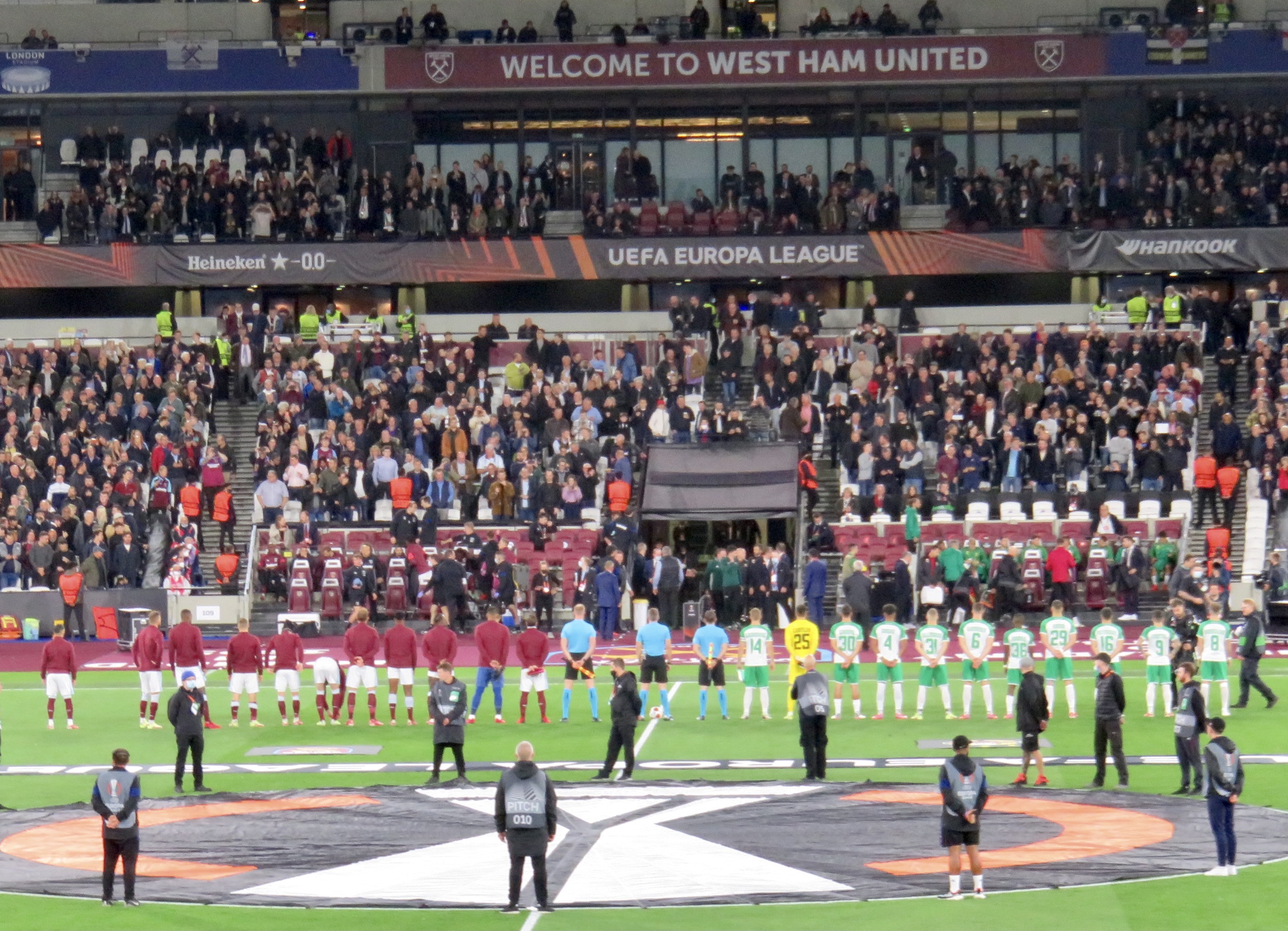It really was not that long ago that West Ham United were a club completely and utterly mired in chaos. Fighting relegation due to a persistently neglected squad amidst a disastrously dispiriting stadium move with the demolition of the beloved Boleyn, whilst simultaneously enduring a deeply distrusted ownership group and general toxic atmosphere within the fanbase culminating in the infamous corner flag bearer, it seemed as though West Ham were a club dramatically on the decline. With seemingly no plan, no idea, and no sense of direction, it seemed inevitable that West Ham were sluggishly drifting towards another foray into England’s second tier.
West Ham had sold their soul, divided their supporters, and on the pitch simply couldn’t buy a win. It seemed as though there was no way out. “I wouldn’t be averse to a season in the championship”, murmured disgruntled supporters, seemingly having already mentally accepted that relegation was impending. The thought of playing championship football in a half-empty stadium, never mind in the soulless Olympic Stadium, against the likes of Burton Albion and Rotherham United, everything just seemed so utterly depressing. Yet fast forward to now, bizarrely just three seasons later, and West Ham have just ended the most incredible European journey – one that so few would have ever foreseen. So, how on earth did that happen?
There’s no getting away from it. The stadium move was soul-crushing. Whilst the allure of a shiny new stadium and the promise of heightened success seemed to bewitchingly grip a proportion of the fanbase, many conversely felt that it had wrought on the community the death of West Ham United as we knew it, with the club embarrassingly having voluntarily abolished everything that had made it unique. Green Street (the actual street, not the hooligan film), Nathan’s Pie and Mash, the Boleyn pub, and of course the Boleyn’s electrifying atmosphere itself, had all been lost, the beating heart of the local Upton Park community stripped out with no life support; everything so heartbreakingly taken away from generations of supporters. For what exactly? Apparently for West Ham’s dramatic ascent up the table, challenging for trophies, and for big European nights. Big European nights? You must be joking. It all seemed so laughable.
The preposterous absurdity of such claims stemmed from the fact that the club was too busy fighting relegation. Drifting towards the bottom-end of the table under once Premier League champion Manuel Pellegrini, the club took the decision to sack the Chilean, only to appoint David Moyes, who was weirdly (given his great success at Everton) attempting to rebuild his image after failures at Manchester United, Sunderland and Real Sociedad. Moyes was given the unenviable task of steering a sinking ship towards safety. The Scotsman had previously held the role before, for the latter stages of the 2017-18 season, guiding the Hammers home to a mediocre 13th position finish. It seems implausible to say it now, but even the re-appointment of David Moyes seemed so uninspiring.
To make matters worse, when Covid hit, amongst talk of how the season was ever going to be finished, or potentially curtailed, points per game quickly became a distinct option. An option that would have taken West Ham down. Thanks to the cringey-named notion of #ProjectRestart, the season continued, with the Irons remarkably managing to turn their season around and miraculously managing to stay up after a strong end to the season. The turning point came with a 3-2 win over London rivals Chelsea, managed by West Ham old boy Frank Lampard. But what was the point in staying up? Just to have another miserable season in the top-flight? To merely delay West Ham’s inescapable descent down the divisions by another season? Yes, things really were that negative.
And that’s exactly how Moyes’ rebuild began. With many predicting that this was the season the Hammers would be finishing rock-bottom in 20th place, things were kicked off with a 2-0 home defeat to Newcastle United, with an utterly horrific set of fixtures to come. The likes of Man City, Liverpool, Arsenal and Spurs were all to be played in the coming weeks, emanating a great sense of a forthcoming season of doom. Where on earth were the points coming from?
And yet West Ham surprised everyone, taking some big scalps, and steadily climbing up the table. Blighted by expectations of it at some point all going wrong, this time it simply didn’t. There was no let up. Remarkably, the club found itself within touching distance of a European place – something that had been so utterly inconceivable just a season before. From going down on points per game, to a potential European spot, within the space of a few months, it wasn’t quite clear what was going on. Whilst the Champions League was always going to be a stretch, the Europa League was eminently possible. Even the newly-inaugurated Conference League, whilst perhaps not a club’s main priority, for a club having been deprived of a European adventure for over twenty years, boy would you take it. And so, they did it. West Ham finished 6th, qualifying for next season’s Europa League, capping off an extremely memorable season. Wait, so were the owners right? Was this all genuinely part of some grand master plan, with Gold, Sullivan and Brady successfully pulling the strings? Were West Ham now in Europe because of the stadium move? Or did it just so happen?
Drawn in a group with Dinamo Zagreb, Rapid Vienna and Genk, it goes without saying that the initial target was reaching the knockout rounds. Whilst the aforementioned teams are historic clubs with a great sense of European pedigree, a vision for West Ham reaching the latter stages of the competition became clearer as West Ham, on paper, probably had the better team. The Hammers immediately laid down a marker, beating Dinamo Zagreb 2-0 in the Croatian capital on a glorious Balkan night in what was their first European game proper for over 30 years. West Ham followed up such an encapsulating performance with home wins over Rapid and Genk. Their form on the road continued, picking up a valuable point in a pulsating 2-2 draw with Genk, before putting in a cultured display in front of their Viennese tourists, confirming their spot as group winners. Despite losing the final group game, West Ham could relax. They were in the last-16 of a major European competition. How far could West Ham really go?
Sevilla. Perhaps not the draw you’d want for your first European knockout game since 1981. 5-time Europa League winners and all-round European specialists, Sevilla represented an incredibly tricky task, with the thought of exiting the competition relatively early an anticlimactic end to what had been an incredibly exciting journey. 4000 Hammers fans made the trip to a sun-soaked Ramon Sanchez-Pizjuan Stadium, only to see their team lose 1-0 despite putting in a heroic display. But more importantly, West Ham were still in the tie.
There was something in the air that night at home to Sevilla. You could sense that something magical could really happen. This was the night that this West Ham team came of age, firmly leaving the ghosts of the Boleyn behind. Perhaps for the first time since the Boleyn’s final bow back in 2016, the London Stadium possessed an atmosphere to match, with the famous rendition of ‘bubbles’ as the teams walked onto the turf wonderfully spine-tingling, and reminiscent of all the good times throughout the generations. West Ham had moved onto pastures new for nights like this. Was it all starting to make sense? All the trauma, the talk of the lost soul, it felt as if it was all being violently crushed beneath the compounding force of the spirit of the Boleyn. Perhaps West Ham never needed to move for nights like this, though this particular night nonetheless represented a watershed moment for the club. It was the night the club could finally move on, the night, dare I say it, that the London Stadium finally became home. West Ham needed special European nights hitherto not experienced at the Boleyn simply as a means of differentiating the past from the present. For all the nostalgia and romanticism surrounding Upton Park, nights like this were not experienced there.
A wonderful Tomas Soucek header put the Hammers 1-0 in front, and that was how it finished at the end of 90 minutes. Into extra time we went. But the feeling all night was that there was only going to be one winner. After swathes of attacking chances, it appeared as though the game was petering out with penalties looming. Until, a certain Andriy Yarmolenko popped up to tuck away the rebound from Pablo Fornals’ shot. Reeling away in celebration, sending the London Stadium into raptures, West Ham could now touch the quarter-finals. The fact that the moment was made even more touching due to Yarmolenko’s difficulties with coming to terms with events in his Ukrainian homeland, capped off an incredibly special and memorable night in East London. Though, some things really are more important than football.
And so West Ham marched into the quarters, ready to face a Lyon side who had reached the Champions League semi-finals as recently as 2020. West Ham couldn’t do it again could they? In their first European quarter-final since losing to Dinamo Tbilisi in 1981, the game started well for the Irons, creating some good chances, but the major talking point from the game was a dour one. Aaron Cresswell was sent off for a foul in the 53rd minute, completely deflating the buzzing crowd. Despite this, the excitable Jarrod Bowen put the Hammers in front, before Tanguy Ndombele levelled for the visitors, giving them the advantage heading into the second leg. A Spurs player landing a potentially fatal blow to West Ham’s European adventure was something that greatly burdened the minds of supporters. But it was only 1-1 heading into the return leg in France.
After soaking up a barrage of early pressure in Lyon, West Ham took the lead, thanks to a powerful Craig Dawson header. The lead was quickly doubled by captain Declan Rice with the Hammers surprisingly leading 2-0 at half-time. A first European semi-final since 1976 was within reach, with just another half to go. And truth be told, the visitors’ grip on this tie was never going to be dismantled. West Ham’s Jarrod Bowen added a third late on, with his side powering themselves into the semi-final. Some of the most feared teams in this season’s edition of the Europa League had been utterly dismembered by a strong West Ham side. Sevilla, then Lyon, but Eintracht Frankfurt were next.
Amidst all the hype of West Ham reaching their first European semi-final since the Cup Winners’ Cup of 1976, the unfortunate truth is that the Hammers never got going, with a disappointing exit at this stage of the competition appearing imminent. Finding themselves 1-0 down within just 40 seconds isn’t what you would call an ideal start, particularly to your biggest game in the best part of 50 years, but West Ham kept pushing. Michail Antonio found the equaliser, only before Knauff restored the Germans’ lead. A spectacular overhead effort from Bowen, clattering the bar, almost levelled things up, but Frankfurt left the London Stadium with a 2-1 lead, leaving West Ham with it all to do in Germany against the 1980 UEFA Cup winners, and 1960 European Cup runners up.
Any real hopes of West Ham propelling themselves into the final, against the odds, were blemished by yet another Aaron Cresswell red card. His second in consecutive rounds of the competition left the Hammers frail, with Eintracht soon finding the lead. Whilst West Ham fought hard and kept it only at 1-0 on the night, the remarkable European journey had come to an end. And so had the dreams of Mark Noble lifting silverware in his final West Ham season.
Yet the point of all this is not that West Ham failed to win the Europa League. But rather that this wonderful European run has given a new lease of life to a club that was in desperate need of oxygen. Not only has this been an important season in terms of on-field success, but it’s been vital for the club’s identity. As the dust settled on West Ham’s European journey, perhaps it was only ever going to end in one way. Just like the song says, “they fly so high, they reach the sky, and then like my dreams they fade and die”. Indeed. But what a fitting way to a season that will undoubtedly live long in the memory.











